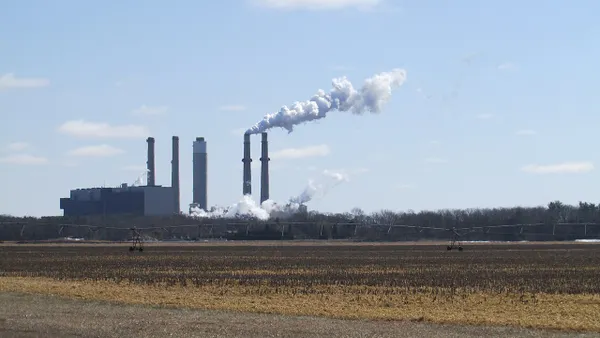Dive Brief:
- Akron, Ohio-based Echogen, a developer of scaleable heat-to-power systems, has been tapped by the U.S. Department of Energy with a $1.3 million grant to develop a 10 MW coal demonstration project that will rely on high-pressure, heated carbon dioxide to generate cleaner power, the Akron Beacon Journal reports.
- Echogen will partner with two other companies and the Electric Power Research Institute on the Supercritical Carbon Dioxide Brayton Cycle test facility; the combined team received a total of $3.9 million for the project.
- The "supercritical" portion of the project refers to carbon dioxide held in a fluid state above its critical pressure and temperature, according to Sandia National Laboratories.
Dive Insight:
The "supercritical" CO2 system will start small, but Echogen's model is based around building scaleable power systems. Initially, the project will be able to power about 10,000 homes, but the company's CTO says the potential reaches far beyond that.
“This plant, generating 10 MW, is just a demonstration,” Echogen's Tim Held told the Akron Beacon Journal. Down the road, the technology could be used to serve much larger loads. The plants would require less fuel to generate power when using the "supercritical" carbon dioxide (SCO2), resulting in lower emissions.
Echogen will be working with the Louis Perry Group, which will be charged with plant design and costing, as well as Optimus/Chanute, which will focus on a waste heat exchanger design. EPRI will also be assisting on materials and utilities consulting.
Work by the three teams will support the future commercialization of SCO2 Brayton cycle energy conversion systems to help meet climate and energy goals, create jobs, and facilitate industrial competitiveness in the United States.
The SCO2 Brayton cycle energy conversion system transforms heat energy to electrical energy through the use of a "supercritical" fluid, rather than through traditional steam systems commonly in use today in nuclear, coal, gas, and concentrating solar plants, and has the potential to be much more efficient.
According to the DOE, the average efficiency percentage traditional Rankine steam cycle is in the lower 30%-range, while the thermal efficiencies of modern supercritical steam cycles are in the low 40% range.
“SCO2 technology has the potential to improve the efficiency of our power plants significantly. Use of the technology in electric power generation could reduce greenhouse gas emissions that contribute to climate change, and also boost our economy,” Franklin Orr, Under Secretary for Science and Energy at the U.S. Department of Energy, said in a statement. “This funding will help these three teams develop proposals for a sCO2 test facility, which ultimately will bring us closer to our goal of deploying this technology on a commercial scale.”
Echogen and its partners will "develop the first process designs for closed steam cycle power plants that use SCO2 for oxy/coal-fired SCO2 heaters," according to the department.
"Over 24 months, the team will identify technology gaps in the SCO2 Brayton power cycle plants, develop cost estimates for the plants, identify opportunities to optimize costs via changes to plant design, and identify components whose cost might be reduced by focused research and development," the department's page on advance combustion systems reads.














